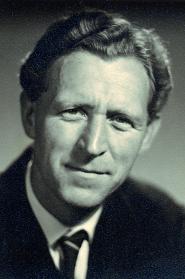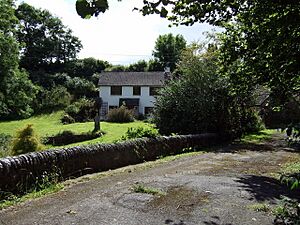Samuel Victor Perry facts for kids
Quick facts for kids
Samuel Victor Perry
|
|
|---|---|
 |
|
| Born | 16 July 1918 Isle of Wight, England
|
| Died | 17 December 2009 (aged 91) |
| Nationality | British |
| Education | University of Liverpool, University of Cambridge |
| Known for | Myosin light chain phosphorylation |
| Spouse(s) | Maureen Shaw |
| Children | Three |
| Awards | Fellow of the Royal Society |
| Scientific career | |
| Fields | Muscle biochemistry |
| Institutions | University of Cambridge, University of Birmingham |
| Influences | Kenneth Bailey, Setsuro Ebashi |
Samuel Victor Perry (born July 16, 1918 – died December 17, 2009) was a British scientist who studied how muscles work. He was a pioneer in the field of muscle biochemistry.
Before becoming a famous scientist, he was also a talented rugby union player. He played for clubs like Southport R.F.C. and Cambridge University R.U.F.C.. He even played for the England national team! Later in his life, he helped many research groups and charities, including the British Heart Foundation. He became a Fellow of the Royal Society in 1974, which is a big honor for scientists.
Contents
Early Life and Studies
Samuel Perry was born on the Isle of Wight in 1918. He grew up in King's Lynn and then Southport, where he went to King George V School. When he was 13, his father passed away. His mother worked hard to help him go to university.
He got into the University of Liverpool to study biochemistry. At that time, only a few universities in Britain offered this course. There, he met Rodney Robert Porter, who later won a Nobel Prize. They became lifelong friends. Both graduated in 1939, but their plans for further studies were put on hold because of World War II.
War Hero: A Prisoner of War
Samuel Perry joined the British Army during World War II. He chose to join the Royal Artillery and became an officer in 1941. He was sent to Egypt.
His time fighting was short. In early 1942, he was captured by German forces during a battle. He spent the next three and a half years as a prisoner of war in different camps in Italy and Germany.
Daring Escapes
While in Italy, he tried to escape for the first time. He broke through a German guard line and crawled through a wheat field, but he was quickly caught. A few days later, while being moved by train, he jumped off near Mantua. He walked north but was recognized and recaptured by a German guard who had caught him before!
He was then moved to camps in Germany. During another train journey, he made his third and final escape attempt. He and a friend cut their way out of a cattle car and jumped from the moving train. Again, he was caught by a German patrol. He was even put in solitary confinement for a month for damaging the train!
Learning in Captivity
Even as a prisoner, Perry kept learning. He managed to keep a science book, the Annual Review of Biochemistry of 1942. He even taught biochemistry and agricultural chemistry courses to his fellow prisoners. He was finally freed by the United States Army.
Amazing Science: Muscle Research
After the war, Perry went to the University of Cambridge to get his PhD. He worked with famous scientists like Fred Sanger, who also won a Nobel Prize. Perry became known for his important work on muscles. He won a special prize for his PhD research. In 1948, he married Maureen Shaw, an artist and actress.
In 1959, he moved to the University of Birmingham to lead a new biochemistry department. He also worked with important research groups like the Medical Research Council and the British Heart Foundation. He spent 20 years helping the Muscular Dystrophy Campaign, a charity that supports people with muscle diseases.
How Muscles Work
Perry's research helped us understand how muscles contract. He found a way to study tiny parts of muscle cells called myofibril. He discovered that a very small amount of calcium is needed for muscles to contract. This was a huge step in understanding muscle movement!
Later, another scientist named Setsuro Ebashi found a special factor called troponin that helps muscles respond to calcium. Perry continued his research, focusing on how different parts of muscle proteins work together. His work laid the groundwork for understanding how muscles move in our bodies.
In 1974, he became a Fellow of the Royal Society. He wrote over 300 scientific papers during his career.
Rugby Star
Samuel Perry started playing rugby at school in Southport. He played for Southport RFC from 1937 until 1940, when the war stopped games.
After the war, while studying at the University of Cambridge, he joined the university rugby team. He played in two big games called the Varsity Matches in 1946 and 1947. He played so well that the English national team noticed him.
Playing for England
He played his first game for England in 1947 against Wales. England won that game 9–6! He played one more game for England in 1947.
In 1948, he played for England against the touring Australian team. Even though England lost, Perry was chosen to play for a special invitational team called the Barbarians against the same Australian team. The Barbarians won that exciting game!
Perry played in all four games of the 1948 Five Nations Championship for England. However, England had a tough time that year. After this, Perry decided to focus on his science career instead of playing more international rugby.
Family Life
Samuel Perry married Maureen Shaw in 1948. They had three children. In 1959, they bought an old watermill in Wales and spent many years fixing it up. After he retired, they moved to the watermill permanently.
Samuel Victor Perry passed away on December 17, 2009. He is remembered for his amazing contributions to science and his exciting life.


